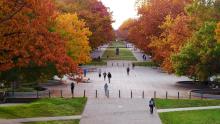UBC botanists have placed seaweed in the underwater equivalent of a wind tunnel to get a better idea of how different types of algae withstand the onslaught of strong waves and currents.
The findings, published in the American Journal of Botany, show that bladed and branched seaweeds take very different approaches to surviving stormy waters--some reducing their surface area in the face of increased turbulence, others actually changing shape to cope.
Seaweeds are important foundational species that are vital both as food and habitat to many aquatic and terrestrial shore organisms. Yet seaweeds that cling to rocky shores are continually at risk of being broken or dislodged from their holds by crashing waves with large hydrodynamic forces. So how do such seaweeds survive in intertidal zones? Do they have special properties that make them extremely flexible or particularly strong?
Patrick Martone, Assistant Professor with the Department of Botany, has spent a considerable amount of time standing on the shore watching big waves crash against intertidal rocks and wondering how the seaweeds—or anything else—manage to survive there.
"Many animals can run and hide when storms roll in and the waves increase," Martone observes. "But seaweeds don't have that option. They have to just hold on tight and face the waves head-on."
Indeed, the drift algae that pile up on the beach after a big storm suggest that not all algae are able to survive such onslaughts. So what is special about the ones that do survive?
Previous research has found that one solution seaweeds have come up with is flexibility. Blades of seaweed may curl up and branches may collapse, thereby changing the shape of the seaweed and reducing drag as water velocity increases. But different seaweeds may utilize different strategies to effectively reduce drag, such that some may be better at changing shape and others at reducing size. Martone and colleagues from Stanford University and St. John Fisher College were interested in teasing apart some of these variables and published their findings recently in the American Journal of Botany.
By exploring the dynamics of size and shape changes of intertidal seaweeds at different rates of water flow, Martone and co-authors hoped to better understand the various strategies that have led to the morphological diversity in macroalgae seen along wave-swept shores.
The authors collected fronds from six different species of algae (four branched, two bladed) along the intertidal zone of the central Californian coast, placed them in a recirculating water flume, and measured the drag they experienced and the changes in shape and size they underwent under 15 different rates of water flow, ranging from 0 to 4 m/sec.
Interestingly, they found that while all six species of seaweed underwent severe reconfiguration as water velocity increased—thus limiting the drag they would otherwise experience if they were rigid—the two types of algae accomplished this in slightly different ways.
"Unbranched algae seem to be 'shape changers,' reducing drag primarily by folding and collapsing in flow," notes Martone. "Certain branched algae, on the other hand, are 'area reducers,' compensating for drag-prone shapes by reducing frond size through branch reorientation and compression. Thus, we demonstrate that flexibility acts in two distinct ways: permitting wave-swept algae to change shape and to reduce frond area projected into the flow."
Martone and colleagues also wanted to see how accurately responses at slow speeds of water flow could be extrapolated to what happens at higher speeds, such as what the seaweeds might be experiencing along the shore.
"Most structural engineers have it easy," Martone says. "Studying air flow around airplane wings or water flow around bridges is relatively straightforward, since these man-made structures are rigid and do not deform in flow. Seaweeds are more complicated because they are flexible. As flow speeds increase, flexible seaweeds re-orient and reconfigure, changing size and shape to reduce drag, making predictions much more difficult."
Indeed, the authors found that measurements extrapolated out from lower speeds did not always match those observed at higher speeds, making it tricky to predict what would happen at higher water velocities. Moreover, in the experimental water flume seaweeds may have more time to react to water speeds that are relatively slow compared with breaking waves—a condition whereby fast reaction times may be crucial for reconfiguring and reducing drag.
"Understanding how selection can act on the ability to change shape or the ability to reduce size in flow may give us insight into the morphological evolution of intertidal algae," summarizes Martone.
Martone concludes that further investigation is still needed to tease these features apart: "We have started building flexible models of branched and unbranched seaweeds in the lab to explore how precise changes in branching affect drag. We hope this work will help us better understand how waves have sculpted seaweeds over evolutionary time."
Musqueam First Nation land acknowledegement
We honour xwməθkwəy̓ əm (Musqueam) on whose ancestral, unceded territory UBC Vancouver is situated. UBC Science is committed to building meaningful relationships with Indigenous peoples so we can advance Reconciliation and ensure traditional ways of knowing enrich our teaching and research.
Learn more: Musqueam First Nation
Faculty of Science
Office of the Dean, Earth Sciences Building2178–2207 Main Mall
Vancouver, BC Canada
V6T 1Z4

